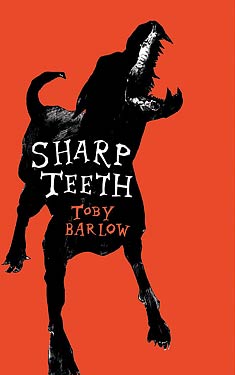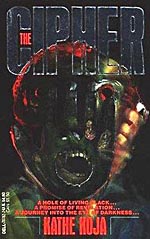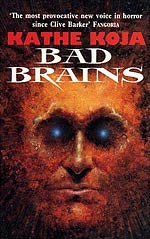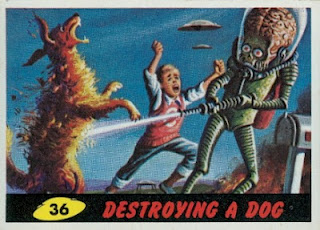WoGF Review: Centuries Ago and Very Fast by Rebecca Ore
 Guest blogger and WWEnd Uber User, Charles Dee Mitchell, has contributed a great many book reviews to WWEnd including his blog series Philip K. Dickathon and The Horror! The Horror! He can also be found on his own blog www.potatoweather.blogspot.com.
Guest blogger and WWEnd Uber User, Charles Dee Mitchell, has contributed a great many book reviews to WWEnd including his blog series Philip K. Dickathon and The Horror! The Horror! He can also be found on his own blog www.potatoweather.blogspot.com.
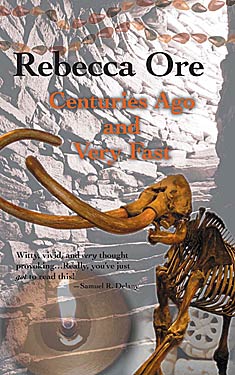 I cringe at author events when some one in the audience asks, Where do you get your ideas? But when I read what Rebecca Ore‘s novel, or series of linked stories, was going to be about, I admit I wondered, How does someone think up this stuff?
I cringe at author events when some one in the audience asks, Where do you get your ideas? But when I read what Rebecca Ore‘s novel, or series of linked stories, was going to be about, I admit I wondered, How does someone think up this stuff?
Vel is a 15,000 year old man who never ages past the prime of his young manhood. He is not immortal, since he could die of an injury or by violence, but except for growing a new set of teeth every century or so, he stays both in excellent shape and immune to disease. He is also a traveler in time and space, a skill he discovered by accident but that has proved handy over the millennia. While other clans are starving during hard times in the Pleistoscene, he can run out for pizza or kill an auroch. In 18th century London, he advises his relatives who run the antique business that supports the family: Buy Hogarth. Invest in woolen mills. Snatch up copies of Gulliver’s Travels, the anonymous author is really Jonathan Swift.
And he is gay. His homosexuality is accepted by his clan. It is neither unusual nor of particular interest. Men like Vel cut down on the competition for women, and Vel and those like him can both hunt with the men and care for children who might otherwise be strangled at birth as that one-too-many child for a still nursing mother.
Great Moments in the Corruption of Youth (2): Too Much Horror Business by Kirk Hammett
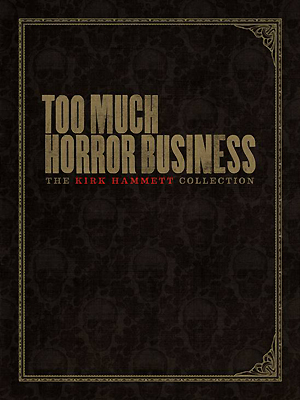 I love the title of this book. It sounds like something my grandmother would have said around the time I was ten years old and she had noticed my copies of Famous Monsters of Filmland, or the Aurora model kits for Frankenstein’s Monster and Dracula, or heard me whining that my parents wouldn’t let me go see I Was a Teenage Frankenstein. (My parent’s had inconsistent rules.) My grandmother would have looked around and said, “When is Dee going to get over all this horror business.” And the answer to that, of course, is never. It takes hold around the age of seven or eight and doesn’t let go.
I love the title of this book. It sounds like something my grandmother would have said around the time I was ten years old and she had noticed my copies of Famous Monsters of Filmland, or the Aurora model kits for Frankenstein’s Monster and Dracula, or heard me whining that my parents wouldn’t let me go see I Was a Teenage Frankenstein. (My parent’s had inconsistent rules.) My grandmother would have looked around and said, “When is Dee going to get over all this horror business.” And the answer to that, of course, is never. It takes hold around the age of seven or eight and doesn’t let go.
This horror fascination is possibly the only thing I have in common with Kirk Hammett, who is ten years my junior but still got hooked around the same biological age. Hammett went on to be the lead guitarist for Metallica, and he has chosen to use some fraction of his disposable income on collecting horror memorabilia in a big way. Too Much Horror Business catalogues his collection of movie posters, toys, movie props, and art. A part of me has to work pretty hard to keep the quotation marks off the word art in the preceding sentence, but he was in a position to buy the original Basil Gogos paintings that became the most famous covers of Famous Monsters of Filmland. Those are cool things to have. He also has a portrait of Bela Lugosi painted in Geza Kende. A little internet research shows that Hammett paid just over $86,000 for the portrait. (Assuming he bought it in auction in 2004.) Kende was a totally forgettable artist, but that price seems about right for something with this kind of special interest.
In his introduction, Hammett states that he did not want the book to be at all academic, and to insure that he decided to compose the text from his own responses to interview questions. He does an excellent job, coming off as a knowledgeable fanboy with a genuine appreciation of material ranging from 1920’s movie posters inspired by German Expressionism to a wallet picturing the Phantom of the Opera in its original packaging!.
 The toys and masks are the most interesting part of the collection. There are pages and pages of movie posters, but the abundance mostly marks the decline of poster design from the silent era to the present day. Perhaps in eighty years, the poster for Hellraiser will be as definitive of its day as Hammett’s posters of The Cabinet of Dr. Caligari seem to be of theirs, but somehow I doubt it.
The toys and masks are the most interesting part of the collection. There are pages and pages of movie posters, but the abundance mostly marks the decline of poster design from the silent era to the present day. Perhaps in eighty years, the poster for Hellraiser will be as definitive of its day as Hammett’s posters of The Cabinet of Dr. Caligari seem to be of theirs, but somehow I doubt it.
Back to the toys. Here the difference in Hammett’s and my age really shows, because while I remained devoted to horror films, I was too old to care about Groovie Goolies or a board game based on Alien. But seeing them now is a kick.
Photographs of Hammett appear throughout the book. In several he performs on the custom guitars he has had made from monster poster images. In another he poses with his young sons surrounded by skulls and models including Frankenstein’s monster, Robbie the Robot, and Ray Harryhausen’s Cyclops from The Seventh Voyage of Sinbad. Father and sons snarl and make monster hands for the camera. The corruption of youth proceeds apace.
Philip K. Dickathon: Counter-Clock World
Guest Blogger and WWEnd Member, Charles Dee Mitchell, has contributed a great many book reviews to WWEnd and we’ve invited him to contribute to our blog. This is the latest in Dee’s series of Philip K. Dick reviews that he started on his blog www.potatoweather.blogspot.com. We’ll keep posting them until he runs out of reviews or gets tired of Philip K. Dick books.
 This is the first Philip K. Dick novel I have read in seven months, and I have to say — it felt like coming home.
This is the first Philip K. Dick novel I have read in seven months, and I have to say — it felt like coming home.
The Dickian weirdness begins on page one. A policeman patrolling a rundown cemetery hears a familiar sound. A recently revived corpse calls out from her grave, “My name is Mrs. Tilly M. Benton, and I want to get out. Can anyone hear me?”
Dick published Counter-Clock World in 1967 and set it in the near future of 1998. But in this world, the Hobart Phase has been operating since 1986. Time is going in reverse. The dead are returning to life, and the lucky ones are rescued in time by vitarium operators, those who dig up the “old born,” get them healthy, and then sell them off to the highest bidder. This is usually a family member willing to care for an aged relative who will now, like everyone else on earth, start the process of becoming younger. (Unclaimed old borns become wards of the state.)
Right. The Hobart Phase. That thing where time starts running in reverse. Dick, as is usually the case, cannot be bothered by all the details of such a preposterous notion, at least not to the extent that it might slow down the story. He gives us the bits he finds funniest, most notably the fact that eating has become disgorging, an act done in private. Meanwhile everyone expects at least a daily dose of sogum. They look forward to it like it was cocktail hour and sometimes make a date to meet at sogum palaces. “Sogum,” although it sounds like a combination energy drink and drug, is clearly something to do with excrement, and for once we can be glad Dick spares us the details.
But all the implications of a world truly running in reverse are not Dick’s concern, and don’t let it be yours either or you will never make it through the novel. His plot surrounds the resurrection of a religious leader who the novel’s main character, Sebastian Hermes, proprietor of Cup of Hermes Vitarium, realizes will be a hot property on the resale market. What he doesn’t expect is the world of dangerous intrigues having the Anarch Peak on hand will expose him to. Rome wants him; the current leader of the Udites, Peak’s religion, wants him; and, the librarians and erads, whose job is to keep eliminating knowledge and art that could not yet have existed, they want him bad. They suspect, with good reason as it turns out, that Peak will have insights to the afterlife that other of the old born have not been able to articulate.
Dick puts his rather flat characters through a plot that spans only a couple of days but is filled with lies, bomb threats, assaults, a little adultery, and some soul searching. This is Dick’s most overtly religious novel, although it is hard to know exactly what he is thinking about when it comes to the religious implications of the plot. But he shares that sense of muddle-headedness with his lead character.
Religion, Sebastian thought wearily. More ins and outs, more angles, than ordinary commerce. The casuistry had already gone beyond him. He gave up.
GMRC Review: Approaching Oblivion by Harlan Ellison
 Guest Blogger and WWEnd Member, Charles Dee Mitchell, has contributed a great many book reviews to WWEnd including his blog series Philip K. Dickathon and The Horror! The Horror! He can also be found on his own blog www.potatoweather.blogspot.com. This is Dee’s ninth GMRC review to feature in our blog and the second this month.
Guest Blogger and WWEnd Member, Charles Dee Mitchell, has contributed a great many book reviews to WWEnd including his blog series Philip K. Dickathon and The Horror! The Horror! He can also be found on his own blog www.potatoweather.blogspot.com. This is Dee’s ninth GMRC review to feature in our blog and the second this month.
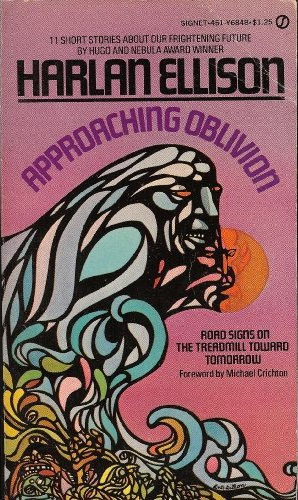 This was my first and is likely to be my only encounter with the writing of Harlan Ellison. It’s not as though I didn’t know what I was letting myself in for. Ellison’s reputation as an old crank, which he wears as a badge of honor, precedes him. I have watched Dreams with Sharp Teeth, the 2008 documentary on him and actually rather enjoyed it. (It might have been very late at night.) But this anthology dates from the mid-1970’s, so he was at most a forty-year-old crank. Old cranks can have undeniable charm and even a sense of gravitas about them. In his forties, Ellison comes off as an over-aged college student with a weighty chip on his shoulder who has just discovered that the world is neither fair nor very nice and goddammit he’s going to tell it like it fucking is.
This was my first and is likely to be my only encounter with the writing of Harlan Ellison. It’s not as though I didn’t know what I was letting myself in for. Ellison’s reputation as an old crank, which he wears as a badge of honor, precedes him. I have watched Dreams with Sharp Teeth, the 2008 documentary on him and actually rather enjoyed it. (It might have been very late at night.) But this anthology dates from the mid-1970’s, so he was at most a forty-year-old crank. Old cranks can have undeniable charm and even a sense of gravitas about them. In his forties, Ellison comes off as an over-aged college student with a weighty chip on his shoulder who has just discovered that the world is neither fair nor very nice and goddammit he’s going to tell it like it fucking is.
I dislike so much about this book I hardly now where to begin, although the title, the subtitle, and the jacket copy seem like a good place. (I read a book club hardback edition.) A book published today with the title Approaching Oblivion could be a screed by Glenn Beck or any number of right wing hand wringers who lament the disappearance of an America they think existed sometime sixty years ago. Hyperbole swings both ways. Ellison caps it off with a subtitle, Road Signs on the Treadmill Toward Tomorrow, a phrase that evokes a self-pitying Jeremiah. Then there is the predictably slavish praise of the promotional copy on the book’s inside flaps. Apparently the New York Times once described Ellison as “relentlessly honest,” a fact relentlessly repeated in almost everything you read about him. Buried on the back flap is this irrelevant and irritating nugget. “[Ellsion} created a series called Starlost and walked away from $93,000 in profits when the producers departed from his original concept.” Mr. Ellison, you are a pillar of integrity. I assume he did accept payment for the episode of The Flying Nun he wrote in 1968. It actually sounds pretty good, a kinky mix that has Sister Bertrille crash-landing on a desert island and patching up the relationship between the shipwrecked lovers she finds there.
GMRC Review: The Listeners by James E. Gunn
 Guest Blogger and WWEnd Member, Charles Dee Mitchell, has contributed a great many book reviews to WWEnd including his blog series Philip K. Dickathon and The Horror! The Horror! He can also be found on his own blog www.potatoweather.blogspot.com. This is Dee’s eigth GMRC review to feature in our blog.
Guest Blogger and WWEnd Member, Charles Dee Mitchell, has contributed a great many book reviews to WWEnd including his blog series Philip K. Dickathon and The Horror! The Horror! He can also be found on his own blog www.potatoweather.blogspot.com. This is Dee’s eigth GMRC review to feature in our blog.
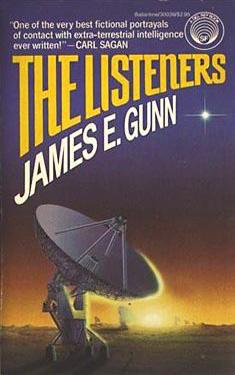 A few pages into The Listeners I thought I was settling down for a pleasantly boring experience of 1970’s science fiction. But halfway through the book, my respect for what James Gunn was attempting — and accomplishing — began to grow. He writes with subdued passion about the commitment of scientists to what many outside their world consider either a fool’s errand or an actual threat to the functioning of society. His “listeners” who work on The Project are fictional incarnations of those who devote their lives to SETI, the Search for Extra Terrestrial Intelligence.”
A few pages into The Listeners I thought I was settling down for a pleasantly boring experience of 1970’s science fiction. But halfway through the book, my respect for what James Gunn was attempting — and accomplishing — began to grow. He writes with subdued passion about the commitment of scientists to what many outside their world consider either a fool’s errand or an actual threat to the functioning of society. His “listeners” who work on The Project are fictional incarnations of those who devote their lives to SETI, the Search for Extra Terrestrial Intelligence.”
The novel, assembled from short stories published in Galaxy and The Magazine of Fantasy and Science Fiction was published in 1974. It opens in 2025, when The Project has existed for fifty years without a result. But in 2027 a message comes through and a reply is formulated. The message is from the star Capella in the constellation Auriga, forty-five light years from Earth. Our reply will take forty-five years to reach the Capellans, and an additional wait of at least forty-five years will follow before we receive a response.
A novel based around almost a century of waiting is not going to be a real page turner, and much of the human interest elements Gunn brings to his plot are either predictable or awkwardly handled. What makes The Listeners a compelling, modernist novel is its use of that extensive time frame, a structure that means characters realize they will not live to see the next stage of their work. Each chapter focuses on an individual who may work for the The Project, but also includes the President of the United States and a fiery Solitarian minister who bases his theology on the fact that man is God’s only intelligent creation. 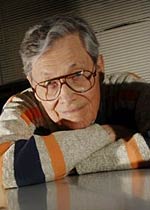 During the course of the narrative, Gunn gives us glimpses of a world undergoing considerable social and political change, changes based largely on the global acceptance of the fact the “we are not alone.” He also uses quotes from real and imagined scientists alongside works by poets and fiction writers to evoke the intellectual ferment The Project arose from.
During the course of the narrative, Gunn gives us glimpses of a world undergoing considerable social and political change, changes based largely on the global acceptance of the fact the “we are not alone.” He also uses quotes from real and imagined scientists alongside works by poets and fiction writers to evoke the intellectual ferment The Project arose from.
In the final chapter, representatives from around the world converge of The Project to hear the Capellan reply. Gunn’s conclusion is emotional, combining both the ending of a civilization and a breathtakingly rich trove of material from that distant galaxy. By 2118, there are in some cases third generation representatives of Project employees on hand. They work in a building that has seen better days, but immediately after the glare of publicity surrounding the Cappellan reply, they return to that building to continue listening for however long it will take the next message to come through. Now they are focusing on the Crab Nebula.
The Hobbit Official Soundtrack – Radagast the Brown
The first musical score for The Hobbit has been released: “Radagast the Brown” composed by Howard Shore.
OffWorld SF Reading Group
 OffWorld is a new science fiction reading group sponsored by WordSpace, a literary organization based in Dallas, Texas. Rather than taking the traditional book club route and reading a single book per month, we are choosing an author to read and discuss over a four-month period. We’ll be meeting as a group locally for discussion, to watch author videos and, from time to time, we’ll bring in outside speakers in addition to holding forum discussions here on WWEnd. If you are in the Dallas area, we would love to have you join in our regular meetings, but it’s with these forum discussions that we hope to bring in as many different voices and opinions as possible.
OffWorld is a new science fiction reading group sponsored by WordSpace, a literary organization based in Dallas, Texas. Rather than taking the traditional book club route and reading a single book per month, we are choosing an author to read and discuss over a four-month period. We’ll be meeting as a group locally for discussion, to watch author videos and, from time to time, we’ll bring in outside speakers in addition to holding forum discussions here on WWEnd. If you are in the Dallas area, we would love to have you join in our regular meetings, but it’s with these forum discussions that we hope to bring in as many different voices and opinions as possible.
Our first author is Neal Stephenson. We are setting up discussions on the books we know members are reading, but feel free to request that we add any book that you have read and would like to discuss. You can also follow our postings on the WordSpace Blog. There we will have links to Neal Stephenson material on the web as well as updates about events in Dallas. Search for OffWorld in the list of topics for all related postings.
Horror Books in Brief: Sharp Teeth, November Mourns, Lullaby and Mr. Shivers
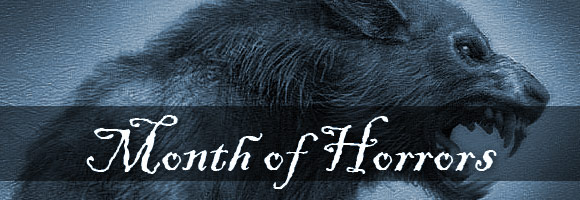
Guest Blogger and WWEnd Member, Charles Dee Mitchell, has contributed a great many book reviews to WWEnd including his blog series Philip K. Dickathon and The Horror! The Horror! He can also be found on his own blog www.potatoweather.blogspot.com.
Let’s see… What would be a really terrible idea for a book?
I’ve got it! How about a novel about werewolves written in blank verse?
But wait, Toby Barlow has already done that with Sharp Teeth, and everything about it is amazing and excellent.
This novel satisfies on so many levels. For those who have always suspected Los Angeles of harboring rival packs of lycanthropes, here is your proof. For those who treasure the thought that true love knows no bounds, including species — again, here is your proof. For those who like complex noirish thrillers about drug lords and shape shifters, let’s face it, it is not going to get any better than this.
I confess, I wasn’t giving Barlow’s novel credit for how complex his tale would be until I realized I needed to back up and figure out just who was who, what pack they ran with, where the bad blood came from, and why those two lycanthropes were playing in a bridge tournament in Pasadena. (When they realize the two sweet old ladies beating them are cheating, one places a phone call to sweet old lady number one and says, “Keep it up and I will chew the flesh off your fingers.” You gotta love these guys.)
But what’s up with the blank verse? Truth be told, after a few pages I couldn’t imagine the story written any other way. Barlow’s verse is straighforward and flourish-free, but if you try printing out some pages as prose you will see it’s not just Raymond Chandler with line breaks. One blurb compares Barlow to Ovid, and I did get the impression that I could be reading a free translation from an ancient writer that stayed true to the spirit of the original. And that original could be very funny, very brutal, and towards the end kind of sad.
The Horror! The Horror! – Kathe Koja
Guest Blogger and WWEnd Member, Charles Dee Mitchell, has contributed a great many book reviews to WWEnd including his extensive Philip K. Dickathon blog series. In this series Dee explores the darker side of genre fiction and it’s practitioners. Be sure to visit his blog www.potatoweather.blogspot.com for more genre goodness.
 If I found a hole into another dimension in the utility closet of my dingy apartment building, I like to think I would contact either MIT or the Institute of Advanced Studies at Princeton. On the other hand, if I was either of the characters from Kathe Koja‘s The Cipher (1991), no, I would keep the discovery as the special plaything for myself and my really pretty awful girlfriend. Then all sorts of horrible and unfortunate things could happen, one of the worst being the appearance of a similar hole in the palm of my hand.
If I found a hole into another dimension in the utility closet of my dingy apartment building, I like to think I would contact either MIT or the Institute of Advanced Studies at Princeton. On the other hand, if I was either of the characters from Kathe Koja‘s The Cipher (1991), no, I would keep the discovery as the special plaything for myself and my really pretty awful girlfriend. Then all sorts of horrible and unfortunate things could happen, one of the worst being the appearance of a similar hole in the palm of my hand.
This is the set up for Kathe Koja’s debut novel The Cipher, one of the three horror novels she wrote in the early 1990’s before turning to YA fiction. I haven’t read the YA novels, but given the content of the three horror novels I have read, she had to make a serious turn to produce YA material. But the switch could do her good, possibly trimming some of the lugubrious fat from the prose of these earlier works. The Cipher, Bad Brains (1992), and Skin (1993) are overripe with grungy, sex-drenched prose, but they work. This is horror that infests a social setting where young people are making bad decisions that push their curiosity for all things dark and weird toward grotesque and tragic consequences.
Koja needs very little of the supernatural for her horror tales. The Cipher concerns what must be a scientific phenomenon that none of the wastrel art students who are dragged into the tale see any need to investigate beyond the fact that it is way cool and weird. In Bad Brains the hero suffers a blow to the head that leaves him with frontal lobe seizures and visions of a malevolent mass of the color silver. I knew that was going to sound ridiculous when I wrote it, but this mass of silver, which any reader is going to write off as a residual hallucination left over from the accident, is really bad news. Running around the country, drunk and stoned and hanging out with strippers, is probably not the best way to deal with it. When the story moves to the derelict home of a brujo in Michigan, the tragedy could be either purely psychological or the result of occult forces. And there is other weirdness that beggars logical explanation. The hero here is an artist, as are most of Koja’s characters. As he travels the northern Midwest, he gets reports from his dealer back home that the paintings he left in his charge are suddenly selling, but their new owners complain that the images begin to change after they get them on the wall.
Skin is Koja’s best novel and the one with the fewest traditional horror trappings. Koja never states a locale for her stories, but she is from Detroit, and a rundown Motorcity, with brutal winters and sweltering summers, seems a likely choice. Everyone is an artist of some sort. I don’t know anything about what the Detroit art scene might have been like in 1990, but none of her artists make anything that seems like it would be taken seriously as art. There is lots of fantasy painting and metal sculpture. But Skin brings in the world of transgressive performance that was an important presence at that time. Koja even credits Survival Research Laboratories and books published by ReSearch in her forward to this novel. Skin is a tale of young people pushing their bodies to ever greater extremes, staging illegal performances with battling machines, real blood, and moments of masochistic ecstasy. Unfortunately, people also die. Koja is not an outsider judging this scene. She chronicles her central character’s slide into madness with unflinching objectivity. The young artists in The Cipher play naively with forces they do not understand and bad things happen. In Skin the artists pursue a vision they will not relinquish even if it destroys them.
Koja’s horror novels are now out of print, but they did not go unnoticed when they first appeared. The Cipher was nominated for the Philip K. Dick Award and Skin was nominated for the World Fantasy Award. Her latest novel, Under the Poppy, is a sexy story set in a 19th century Belgian brothel. Reviews are good, it has won a couple of awards, and it is being adapted for the stage.
Click the book covers to read my reviews of the individual Koja novels.
Great Moments in the Corruption of Youth: (1) Mars Attacks
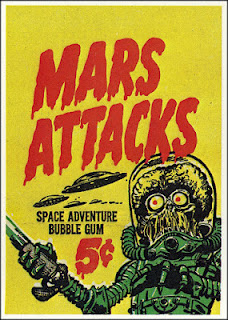 Editor’s Note: This article originally appeared on Charles Dee’s blog Potato Weather.
Editor’s Note: This article originally appeared on Charles Dee’s blog Potato Weather.
The Topps Company is best known for their annual sports trading cards which they have produced since 1938. But they have always maintained other lines ranging from current events to historical themes to novelties. They had dabbled in science fiction before when in the early 1960’s they decided it was time to do a series loosely based on H.G. Well’s The War of the Worlds. Their initial title for the series was Attack from Space, but they wisely scrapped that for the more headline worthy Mars Attacks.
They went into production with the highly regarded pulp illustrator Wally Wood as artist, but they felt his designs were too restrained for what they wanted. They brought in Bob Powell who had illustrated their Civil War series. He gave them what they wanted, lurid scenes of mass destruction balanced against more intimate human/alien encounters. He modeled his Martians on the giant-brained creature from the Jack Arnold film This Island Earth, and he set them about alternately bombarding the great centers of human population and hunting down survivors in devastated suburbs and the blasted countryside.
Management at Topps became concerned as soon as they saw early samples of the final artwork. Too violent and too sexy was their judgment. Hemlines came down and necklines rose. Aliens and the giant insects they created could die as horribly as the artists wanted, but humans transformed into flaming skeletons were a problem. The breaking point came in a scene where an alien — the heartless, inhuman bastard — blasted a boy’s dog with his heat ray. The dog absolutely could not be shown as a flaming skeleton. For some reason repainting Rover with a full coat of fur, albeit flaming fur, passed muster.
 Management was right to be worried. As soon as the first pack of five cards hit the news stands, complaints began coming in. The whole thing was too violent for kids and too suggestive for the general public. The artists began painting out some of the blood in the not yet released packs, but a call from a district attorney in Connecticut brought production to a halt. The series would be prosecuted as unfit for children.
Management was right to be worried. As soon as the first pack of five cards hit the news stands, complaints began coming in. The whole thing was too violent for kids and too suggestive for the general public. The artists began painting out some of the blood in the not yet released packs, but a call from a district attorney in Connecticut brought production to a halt. The series would be prosecuted as unfit for children.
Artists experimented with toning the whole thing down, a process that largely involved replacing female victims with men. This made for inadvertently bizarre images, since the new drawings did not receive new titles. “Prize Captive” depicted an alien abducting what looks to be a teenage boy. The man stolen from his bed in “The Beast and the Beauty” could be that same boy’s father. What does this say about Martian sexual proclivities? But these cards never went into production, nor did the series ever see national distribution.
Instead it became legendary. The cards have always been on the collector’s market, but Tim Burton’s not very good film from 1996 gave rise to a new level of interest. A copy of card number one, “The Invasion Begins,” sold at auction for $80,000. Topp’s had sold off the original artwork in the 1970’s for what I am sure at the time seemed like a good amount of money. Currently on E-Bay, a prototype of the unused Attack from Space packaging has been marked down to a mere $188,000. A set of cards — missing 39 cards! — is $11,000.
 The new Mars Attacks book from Topps presents a brief history of the cards, facsimiles of the original 55 along with the story line, some original drawings, and more current artwork created for recent spin-offs. It is a worthy 50th anniversary celebration. I especially like Card 13, “Watching from Mars.” Martians kick back with red martinis and watch the destruction of the U.S. capitol on a large-screen TV. Pitchers of that red martini mixture show up later in a 1990’s image of a Martian/human wet t-shirt contest. Where is that Connecticut D.A. when you need him?
The new Mars Attacks book from Topps presents a brief history of the cards, facsimiles of the original 55 along with the story line, some original drawings, and more current artwork created for recent spin-offs. It is a worthy 50th anniversary celebration. I especially like Card 13, “Watching from Mars.” Martians kick back with red martinis and watch the destruction of the U.S. capitol on a large-screen TV. Pitchers of that red martini mixture show up later in a 1990’s image of a Martian/human wet t-shirt contest. Where is that Connecticut D.A. when you need him?



















 Full Details
Full Details
